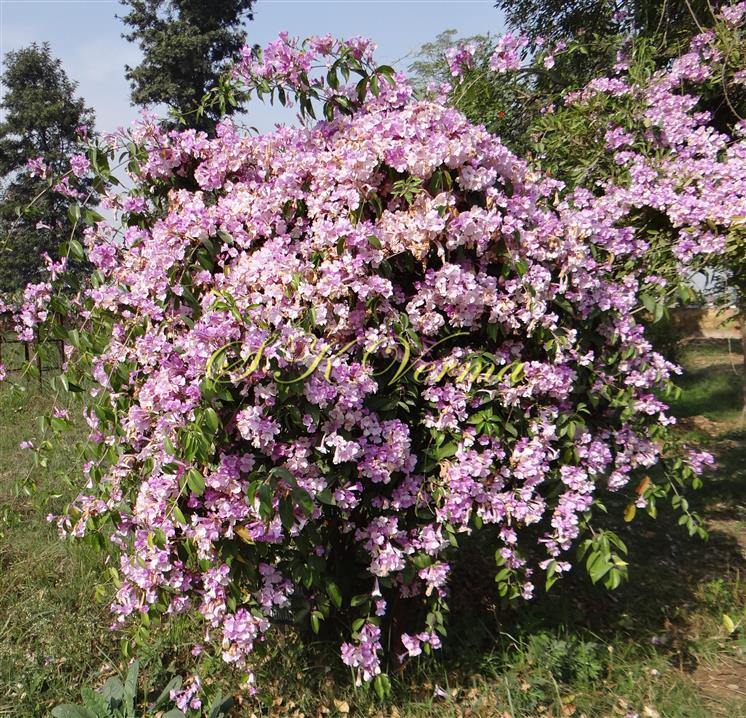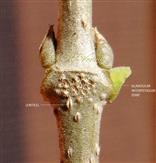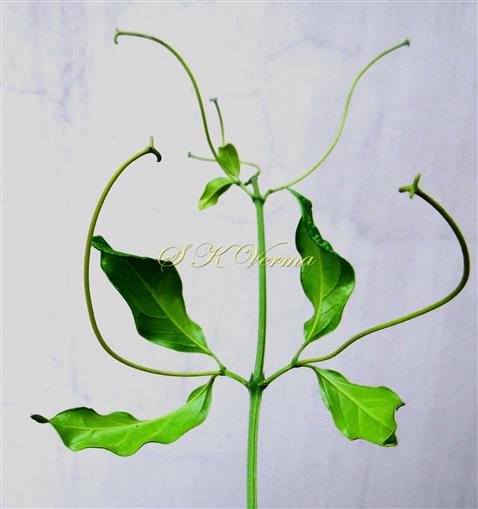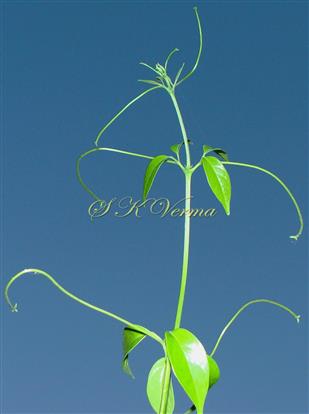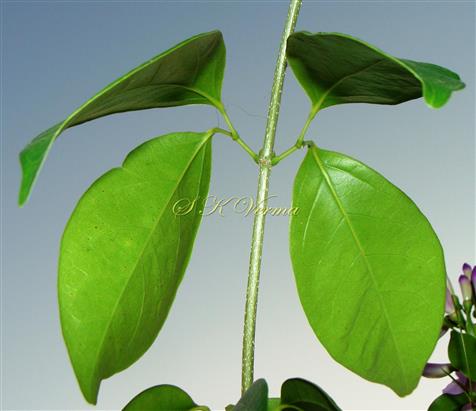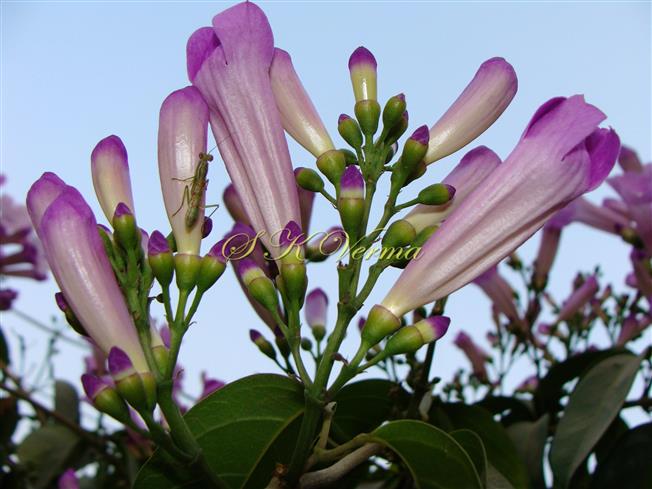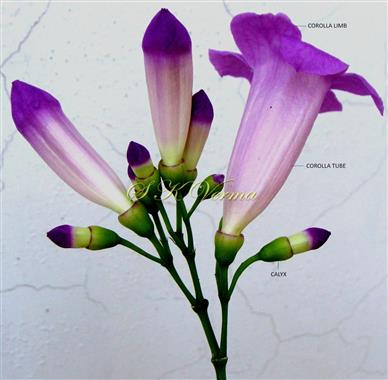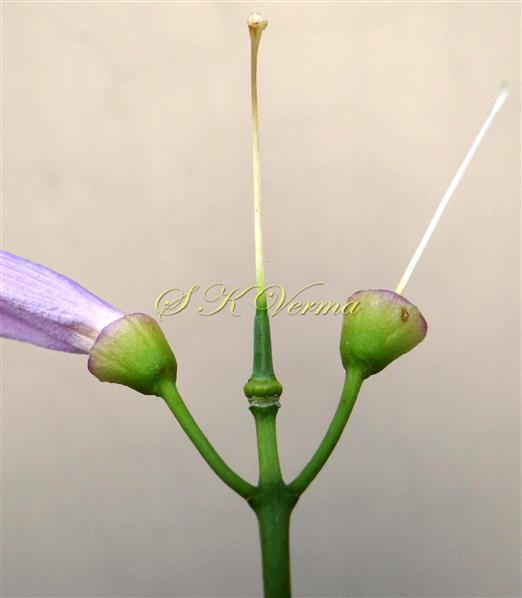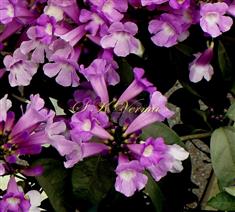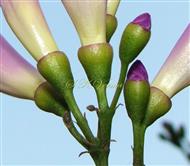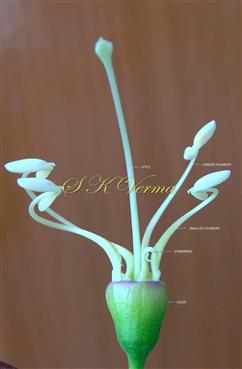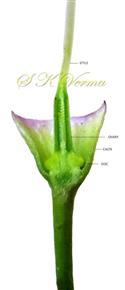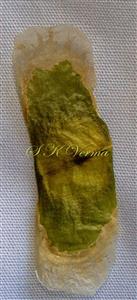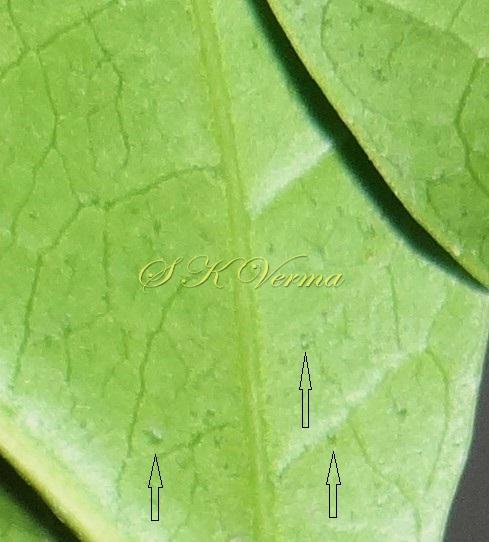MANSOA
Mansoa
DC., Biblioth. Universelle Geneve, Ser. 2, 17: 128. 1838.
Lianas, usually without dimorphic juvenile growth, with garlic odour. Stems with phloem wedges in multiples of 4 in C.S., with solid pith; branchlets cylindrical with older stems becoming angled and ribbed, glabrous to pubescent, with or without sparsely distributed lenticels, with discontinuous interpetiolar ridge, with epidermis not peeling; prophylls of axillary buds triangular and minute or bromeliad-like, nonglandular. Leaves with garlic odour, 2- or 3-foliate, terminal leaflet often replaced by a trifid tendril, tendrils without adhesive discs, with apices not uncinate; leaflets chartaceous, with glands grouped in axils of veins, petiolules not articulated; petiole cylindric. Inflorescence axillary, a thyrse. Flowers bisexual, zygomorphic, pentamerous, hypogynous. Calyx cupulate, shortly 5-lobed or 5-apiculate, coriaceous or membranous, puberulous externally, without or with few glands near margins. Corolla magenta or pink, violet pink, lavender or mauve, without nectar guides, funnelform; tube straight, membranous, puberulous externally; lobes 5, imbricate. Stamens 4, with well-developed filaments, included, anthers glabrous, thecae straight. Carpels 2, syncarpous; ovary sessile, smooth and glabrous, ovules in 2 series on each placenta, stigma 2-lobed, lobes flattened, rhombic, glabrous. Disc annular. Capsules linear, flattened or inflated, straight, woody, with 2 valves, glabrous or villose, without lenticels, smooth except with midrib frequently developed into a prominent ridge, with calyx caducous. Seeds winged, with body smooth and glabrous, wings opaque or hyaline, linear.
18 species
Mansoa alliacea
Mansoa alliacea
(Lam.) A. H. Gentry, Ann. Missouri Bot. Garden 66: 782. 1980; Bignonia alliacea Lam., Encycl. 1(2): 521. 1785; Adenocalymma alliaceum (Lam.) Miers, Ann. Mag. Nat. Hist., ser. 3, 7: 394 (1861); Pseudocalymma alliaceum (Lam.) Sandwith, Rec. Trav. Bot. Neerl. 34: 210. 1937.
Woody vine, climber by tendrils attaining long heights. Mature stem quadrangular, with angles ribbed; young stem cylindrical or subcylindrical, lenticellate; nodes slightly compressed with a glandular interpetiolar zone; pseudostipules (prophylls) ovate, ca. 5 mm long, glands absent. Leaves opposite, 2-foliate, sometimes with a terminal tendril, trifid (without adhesive discs), 17-25 cm long, with garlic odour, deciduous; leaflets 9-15 cm x 4.5-7 cm, elliptical or broadly elliptical, chartaceous, apex obtuse or obtusely acuminate, base acute, rounded or obtuse, sometimes unequal, margin undulate; upper surface dull, glabrous, with venation slightly prominent, lower surface light green, dull, with venation slightly prominent, abaxial surface with minute punctiform glands; petioles and petiolules both 7-30 mm long, puberulent or glabrous,. Inflorescence axillary or terminal panicle of cymes arranged in racemose manner, flowers few in inflorescence. Flowers 6-9 cm long, 4-5 cm across, bisexual, zygomorphic, pentamerous, hypogynous; pedicels 7-15 mm long. Calyx green, campanulate or cupulate, 5-8 mm long, truncate, slightly crenate and ciliolate at apex, apical rim purple. Corolla violet pink, lavender or mauve, slightly zygomorphic, funnelform, 6-9 cm long; tube straight, narrow cylindrical at base, 4 mm wide, flaring upwards with 2 cm diameter below limb; limb 4-5 cm in diameter, slightly 2-lipped, upper lip of 2 lobes and lower lip of 3 lobes, lobes nearly equal, 1.3-1.6 cm x 1.3-1.6 cm, suborbicular to obovate, apex round or emarginate, lobes puberulous externally; throat and tube inside white, without nectar guides. Stamens 4, included, inserted at base of corolla tube, didynamous, 2 large with filaments ca. 2.2 cm long and 2 short with filaments 1.8 cm long, dilated and hairy at the base; staminode 1. Disc cushion-like. Carpels 2, syncarpous; ovary sessile, ca. 4.5 mm long, cylindrical with 2 longitudinal ridges, lepidote, 2-locular, ovules in 2 series on placenta in each loculus, placentation axile; style ca. 2.3 cm long; stigma 2-fid, lobes flattened and rhombic. Capsule linear, flat, woody, light brown, 28-35 cm x 1.5-3 cm, flat, 2-valved, each valve with a longitudinal rib on middle portion, mucronate at apex.
Common Names: Garlic Vine; Lahsun Lata (Hindi)
